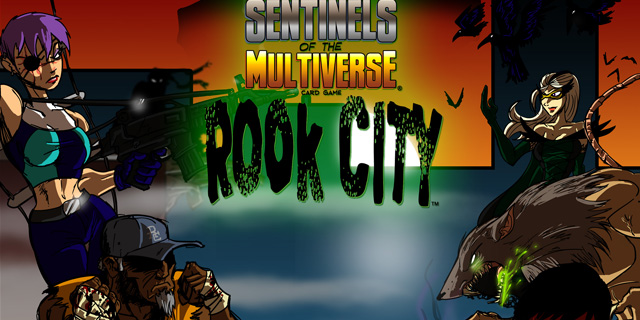
In Greater Than Games’s Sentinels of the Multiverse, not only did many of the heroes (and villains) bear a resemblance to popular comic book characters, but the environments did as well. The base set gave us The Wraith, a female Batman equivalent without the childhood trauma, but the only urban city environment, Megalopolis, felt more like Superman’s (or in the case of Sentinels, Legacy’s) Metropolis than the game’s Gotham City. That particular location, Rook City (dubbed “Crook City” by some graffiti on the back of its cards), would be found in— and serve as the title for— the first expansion for Sentinels. It is every bit as dark and dangerous as its inspiration, and it is not alone in that respect.
In addition to its titular environment deck, Rook City includes two new heroes, four new villains, and an additional environment. Expatriette is the daughter— and nemesis— of the base set’s toughest villain, Citizen Dawn, and what she lacks in actual super-powers she makes up for with guns and ammo, not unlike The Punisher (although like The Wraith, without quite as much of the family trauma of her inspiration). She is joined on the heroes’ side by the enigmatic Mister Fixer, another regular human who uses kung fu and auto repair tools to inflict some serious pain on his enemies. Mostly he directs his efforts towards thwarting a criminal group known only as The Organization, headed up by the equally-mysterious Chairman.

Fighting against The Organization is a unique two-villain experience, as The Chairman initially sits in the shadows while his right-hand woman, The Operative (a former student of Mister Fixer’s), and his legions of underbosses and thugs do most of the work, chaining down the line in a way that feels much more menacing than the base set’s minion-oriented villains Grand Warlord Voss and Citizen Dawn. The other villains include the Joker to Wraith’s Batman, the drug-fueled serial killer Spite; infectious beast-man Plague Rat; and the Hitchcockian swarm of fowl controlled by The Matriarch (nemesis of the speedster Tachyon for reasons currently unexplained). The Pike Industrial Complex, filled with exploding chemical vats and genetically engineered giant rats, provides the setting for the second environment deck.
Rook City has some new tricks to accompany its new decks, the most noticeable of which is the H symbol. Used to better scale the opposition against a varied number of heroes, “H” stands for “the number of heroes that started the game.” Something that inflicts H-2 damage would inflict only one damage if opposed by three heroes, but a painful three damage if up against a full team of five. This actually has the effect of making some enemies feel easier when tackled by a smaller team (and nearly impossible when going five-on-one), whereas three players in the base set were always in for something of an uphill battle and five was often a cakewalk. Now there’s much more variation, and victory feels much more dependent on the specific abilities of each hero than sheer numbers. Other new mechanics include indestructible cards (Spite has several of these, like his drugs) and damage that cannot be reduced (one of Plague Rat’s annoying specialties).

Other than the new stuff that is to be expected from any expansion, Rook City also ups the production level of the game itself. The first change that mot players will probably notice is the fact that the environment cards now have illustrations like every other deck and in general use the same card layout. This is a dramatic improvement over the all-text environments from the base set. The cards themselves are also noticeably thicker and feel much more solid than the somewhat flimsy base set’s.
Expatriette and Mister Fixer have the same number of cards as the other ten heroes, but their decks look like they have about twice as many just due to the height difference. Fortunately, the modular nature of the game means that the new cards never have to be shuffled together with the older ones, so this doesn’t cause issues like it does with Ascension: Chronicle of the Godslayer and its follow-ups. The guys at Greater Than have expressed a desire to re-issue the base set using the new cardstock (giving them the opportunity to errata cards as well), and while there are no concrete plans to do so just yet, I and many other fans would be more than willing to re-purchase the base set just to get illustrated environment decks. At least two more expansions are also in the works — after all, there are several heroes and villains without nemeses, if nothing else, and still plenty of character concepts that can be mined and adapted from nearly a century of comics history.

Sentinels of the Multiverse: Rook City retails for $20, which is less than ten cents per card included in the box (222). You will probably also want to pick up a storage box to store everything, as while it is theoretically possible to cram all of the cards in Rook City‘s larger box, it would be a tight fit and you would still need to accommodate whatever you use to keep track of HP. Besides, a thousand-card capacity long box generally only costs a buck or two at most game stores.



















